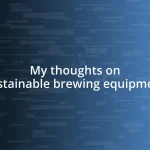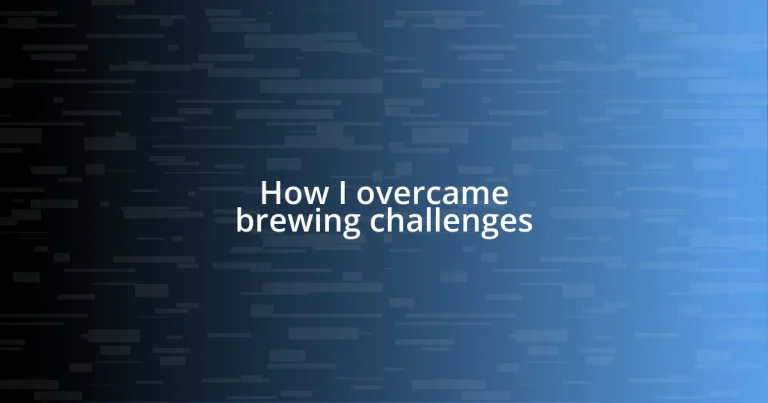Key takeaways:
- Consistency in brewing temperature, water quality, and grind size significantly impacts the flavor and quality of coffee.
- Documenting the brewing process helps identify patterns and refine techniques, enhancing overall brewing skills.
- Engaging with the brewing community fosters knowledge sharing, support, and inspiration, improving the overall brewing experience.
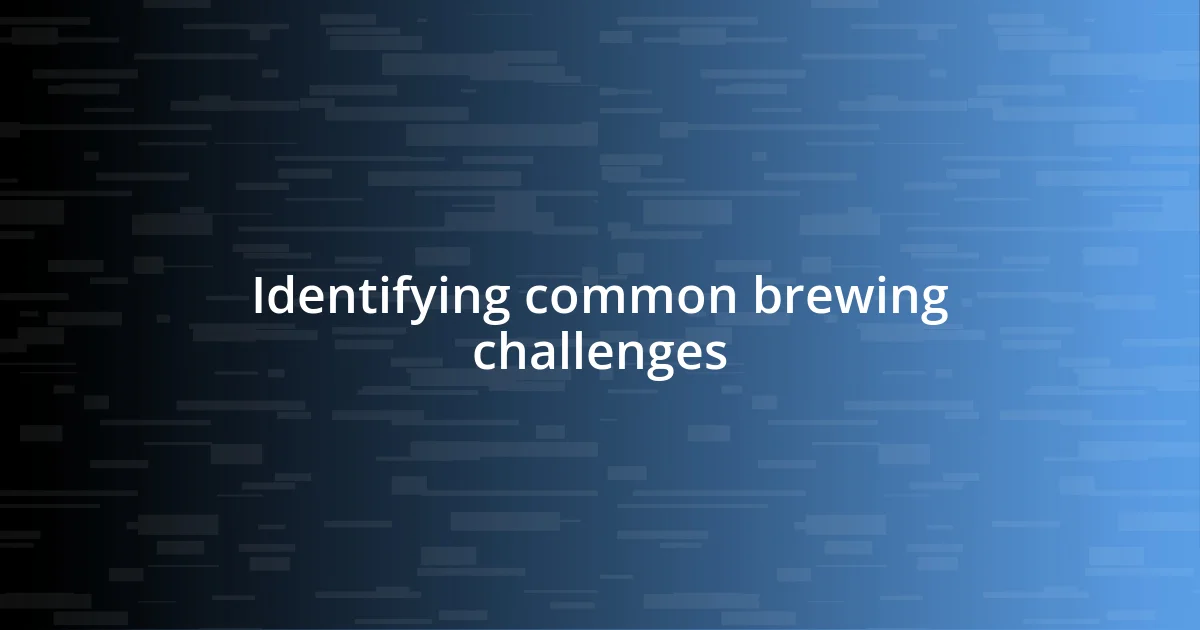
Identifying common brewing challenges
Brewing challenges can often feel overwhelming, especially for those of us who are passionate about crafting the perfect cup. One common issue I’ve faced is inconsistent temperatures during the brewing process. Have you ever poured over your carefully measured ingredients only to end up with an unexpected taste? It’s frustrating, and I find that keeping a consistent temperature can truly be the difference between a cup of joy and a disappointing one.
Another frequent hurdle I’ve encountered is water quality. It might seem trivial, but the water you use can completely alter the flavor profile of your brew. I remember the first time I used filtered water—what a revelation! The difference was astounding. Suddenly, the subtle notes of my favorite beans came to life. This really makes me wonder, how much are we neglecting our water sources in our quest for the perfect brew?
Lastly, let’s talk about grind size. Many people don’t realize that this can dramatically impact extraction. I’ve had my share of experiments with different grind sizes, and let me tell you, the results can vary widely. A coarse grind might leave your brew weak, while too fine can make it bitter. Have you experimented with this yourself? Finding that sweet spot can take some time, but the journey is what makes brewing so fascinating—and rewarding.
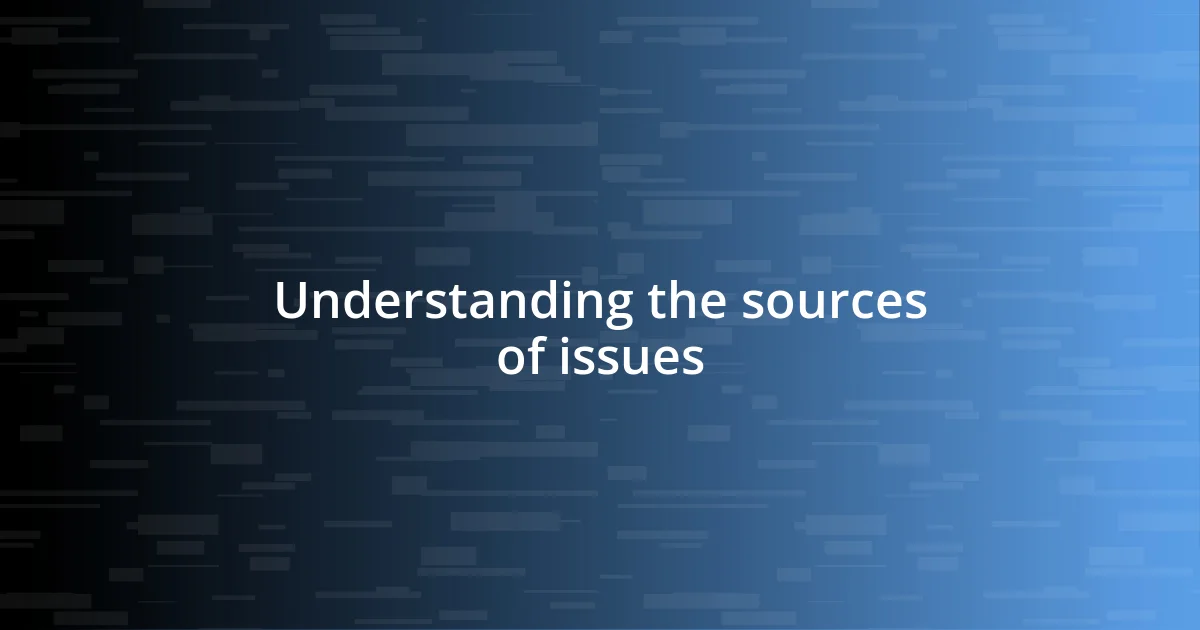
Understanding the sources of issues
Understanding the sources of issues can truly shine a light on the challenges we face in brewing. For me, one major source is the equipment itself. I remember the day I realized my old coffee maker simply couldn’t hold the heat consistently. It was a game-changer when I upgraded. Suddenly, my brews were much more reliable, and I could finally enjoy that rich aroma I had been chasing for years.
Another crucial factor to consider is the freshness of your ingredients. I once bought beans that had been sitting on the shelf for months, thinking I could save a few bucks. What a disappointment! The brew lacked vibrancy, which made me appreciate the significance of sourcing fresh coffee. Now, I always check the roast date and choose beans that are less than a month old. The difference is night and day.
Lastly, let’s talk about brewing time. I used to think longer was always better, but I was surprised to find out that over-extraction can ruin even the finest beans. When I experimented with different brewing times, I discovered my sweet spot—and it was often shorter than I expected. Have you ever felt that exhilaration when you finally dial in the perfect timing? There’s something exhilarating about mastering the nuances of the brewing process that makes all the effort worthwhile.
| Source of Issue | Impact on Brewing |
|---|---|
| Equipment Quality | Affects temperature consistency and brew reliability. |
| Ingredient Freshness | Directly influences flavor and aroma of the brew. |
| Brewing Time | Determines extraction level; affects taste quality. |
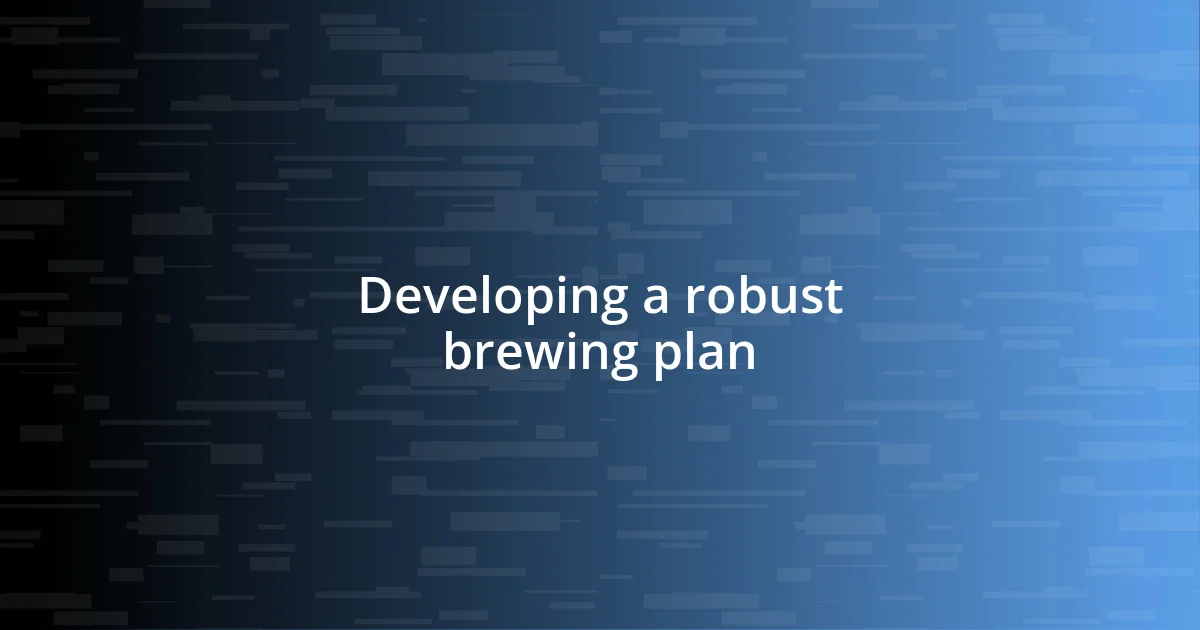
Developing a robust brewing plan
Developing a robust brewing plan
Creating a solid brewing plan has been one of the most transformative steps in my journey. When I first started, I often winged it, hoping for the best. But once I began to chart out my process—ingredients, timings, and methods—I saw everything change. It felt like moving from chaos to clarity. Now, I treat my brewing like a recipe, where precision turns haphazard attempts into crafted masterpieces.
Here are some key elements I include in my brewing plan:
- Ingredient Selection: I meticulously choose my beans based on flavor profiles and roast dates. The more I learned, the more I realized how specific varietals can elevate my brews.
- Equipment Check: Before I start brewing, I always inspect my gear. A clean coffee maker means I won’t encounter unwelcome flavors.
- Brewing Method: I have a set of go-to methods, yet I continually experiment. Each method can bring out different notes in my favorite beans.
- Timing: I’ve committed to using a timer to ensure I don’t over-brew or under-brew. Nothing is more frustrating than ruining a cup through impatience.
- Tasting Notes: I keep a journal to jot down what worked and what didn’t. This has helped me spot patterns over time and fine-tune my approach.
By implementing these strategies, I’ve transformed my brewing process into a seamless and enjoyable experience. It’s about much more than just getting a caffeine fix; it’s about savoring each step along the way, which makes every cup feel like a rewarding achievement.
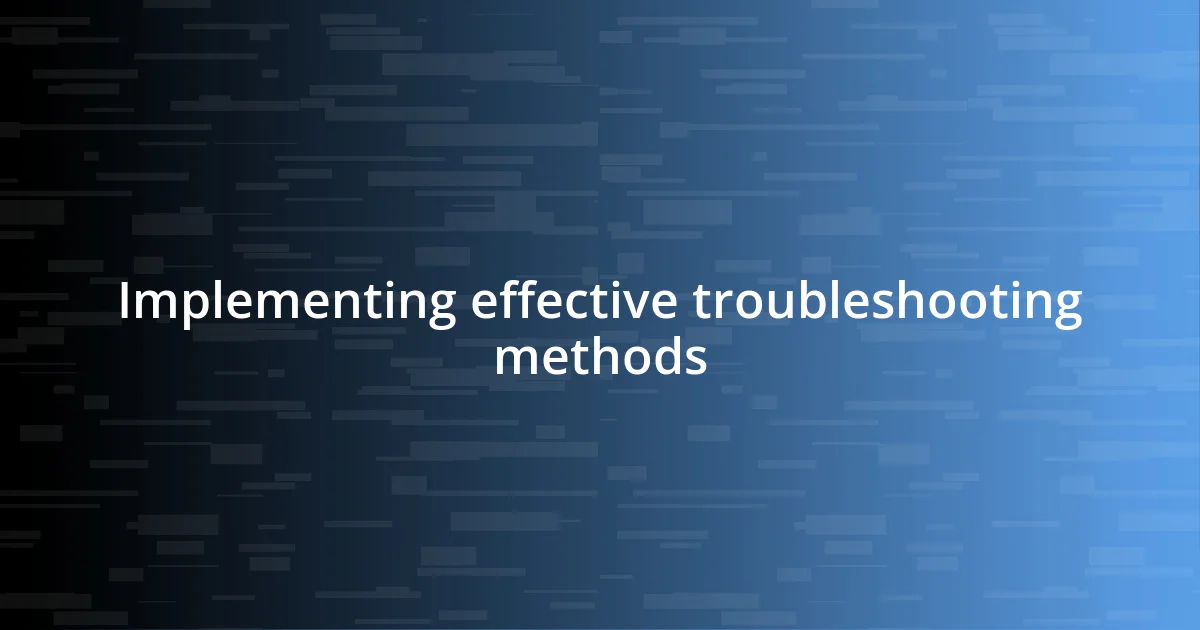
Implementing effective troubleshooting methods
Troubleshooting is an inevitable part of the brewing experience, and I’ve found that approaching it systematically makes all the difference. For instance, I remember a particularly stubborn issue where my coffee kept tasting bitter. Instead of just blaming the beans, I carefully examined each variable—from grind size to water temperature. With a bit of patience, I discovered that adjusting my grind coarseness was the critical change I needed. Wouldn’t you agree that a little detective work can lead to satisfying breakthroughs?
I also advocate keeping a troubleshooting log. When I began documenting my brewing mishaps, I started to notice patterns. It became clear that I was consistently over-extracting when I brewed at higher temperatures. By tracking my mistakes, I was able to pinpoint solutions and really refine my process. This method not only sharpened my brewing skills but also kept the experience engaging. Have you ever kept a log for anything? It’s fascinating how the act of writing can crystallize your journey.
Lastly, don’t hesitate to reach out to the coffee community for troubleshooting tips. After facing multiple challenges, I joined a local brewing group. Sharing experiences, discussing problems, and learning from others helped me find solutions I never would have considered on my own. One member suggested an unconventional brewing technique that turned into a game-changer for me. Sometimes, a fresh perspective is all you need to elevate your coffee game!
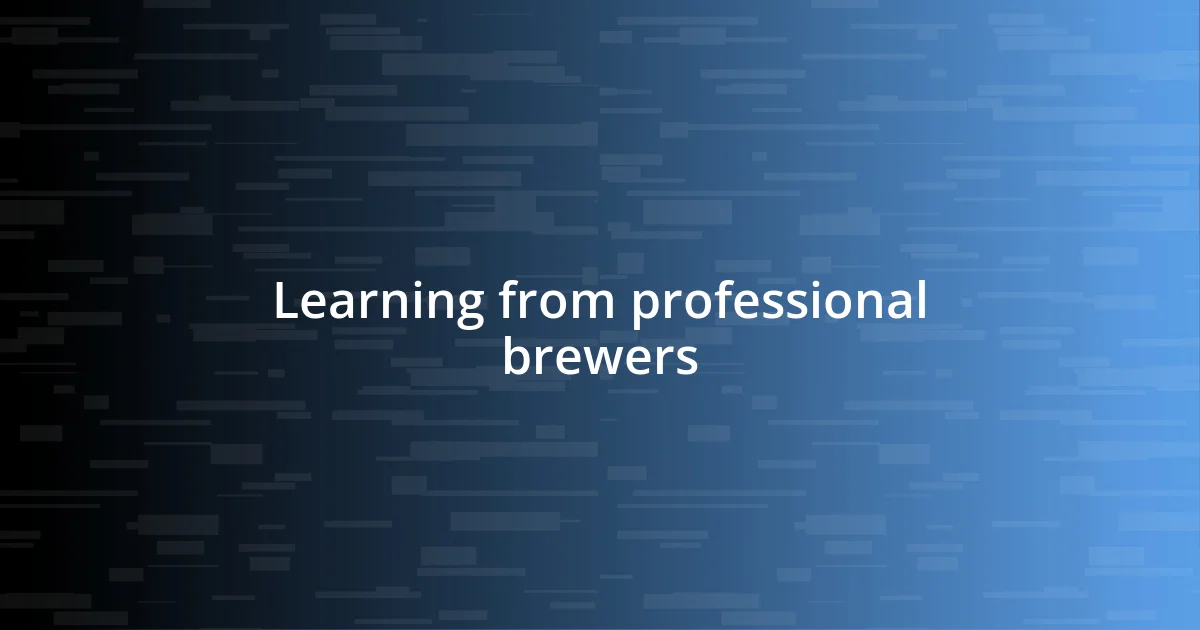
Learning from professional brewers
When I first delved into the world of brewing, I found myself captivated by the expertise of professional brewers. One memorable encounter was during a workshop led by an experienced barista who shared her journey with us. It struck me how she emphasized the importance of consistency over creativity in the early stages. The lightbulb moment came when she highlighted that even simple tweaks—like adjusting the water-to-coffee ratio—could make a world of difference. Have you ever tried changing just one element to see how it impacts the final product?
Another experience that shaped my brewing journey was a candid conversation with a brewmaster during a local competition. He shared his biggest blunders, and it was refreshing to hear that even the pros face setbacks. It reminded me that imperfections can become the foundation for growth, and I learned to embrace my mistakes rather than shy away from them. Isn’t it inspiring to know that every expert was once a beginner?
I also discovered that seeking mentorship from professionals can significantly enhance my skills. At one point, I reached out to a local brew shop for advice on mastering espresso shots. Their guidance on the nuances of tamping pressure opened my eyes to the finesse involved in brewing. It’s incredible how a few practical tips can bridge the gap between good and great coffee, isn’t it? These experiences have not only informed my brewing techniques but also instilled a deeper appreciation for the craft.

Documenting the brewing process
Documenting the brewing process has become an essential part of my journey, almost like keeping a diary of flavors and techniques. I remember the first time I started recording each batch—my notes included everything from bean origin to the specific time I steeped. It was both thrilling and enlightening to look back and trace my improvement over time. Have you ever considered how a simple notebook could transform your brewing skills?
As I refined my documentation approach, I began to categorize my findings. I’d create sections for successes and failures, which turned into a roadmap for my brewing exploits. One particular entry stands out: I noted that my pour-over tasted distinctly different using the same beans based on the day’s climate. It struck me that environmental factors played a bigger role than I ever imagined. Reflecting on these details deepened my understanding of the nuances involved in brewing. Isn’t it fascinating how much we can learn just by paying attention?
Incorporating visuals was another game changer. I took photos of each brewing setup and my final results, which helped me spot trends that my notes alone couldn’t reveal. One image showed a beautifully brewed cup, but the angle revealed my grind size made it too coarse, and the taste reflected that. These snapshots served as both a reminder and a motivating factor to keep improving. How has capturing your brewing journey helped you appreciate the process more? For me, it made each cup not just a beverage but a product of my craft and dedication.

Sharing knowledge with the community
Sharing knowledge with the community has been a game changer in my brewing journey. I remember one evening at a local homebrew club where everyone gathered to share their latest experiments. It was exhilarating to see fellow enthusiasts light up while discussing their unique techniques and brewing mishaps. Have you ever experienced that sense of camaraderie among people who share the same passion? For me, it reinforced the idea that each of us carries valuable insights worth exchanging.
I decided to host a small brewing demo in my garage, inviting anyone curious about the craft. The energy in the room was palpable as I explained my process while fielding questions from eager participants. One particular moment stood out: a young brewer expressed his disbelief at how a small adjustment could change the flavor profile entirely. It felt rewarding to watch his eyes widen as he tasted the difference for himself. Isn’t it amazing how sharing knowledge can spark curiosity and creativity in others?
Even the simple act of posting my brewing experiences online created a ripple effect. I found that sharing a video on a brewing technique not only provided a visual guide for others but also opened up a dialogue about common challenges. It was heartwarming to receive messages from fellow brewers seeking advice, and it reminded me of the power of community. Have you ever felt that deep connection with someone simply because you both share an interest? Those interactions fostered a supportive space where we could all grow together, and I can’t emphasize enough how fulfilling that has been for me.






